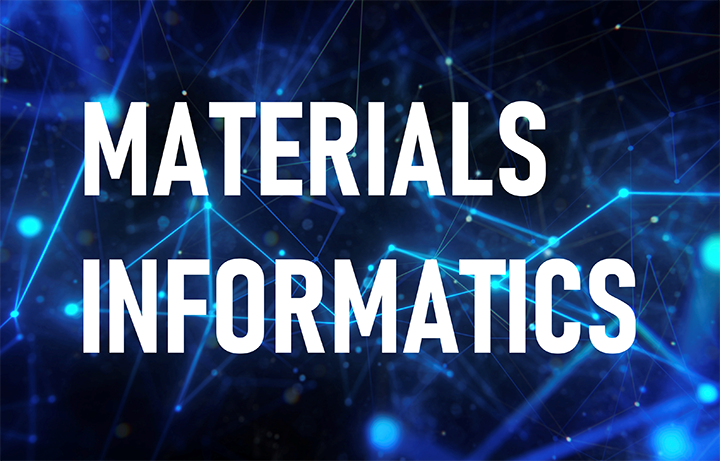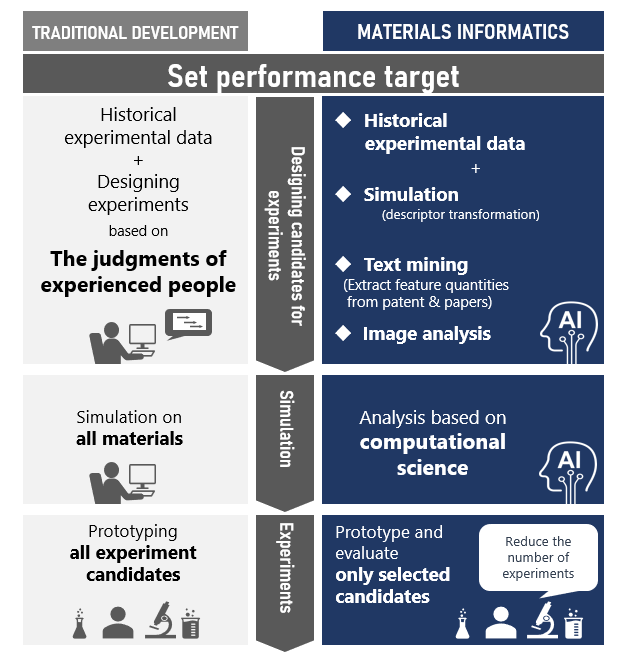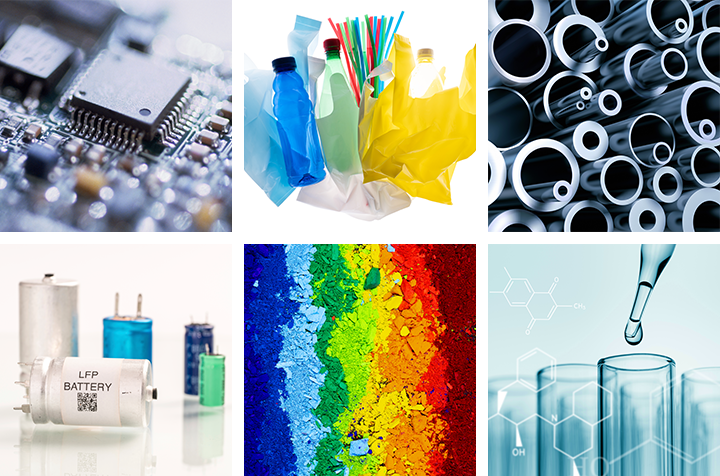MATERIALS INFORMATICS

Table of Contents
WHAT IS MI?
MI stands for Materials Informatics.
It refers to the attempt to improve the efficiency of material development, using information science and computational science methods such as vast amounts of experimental data, material data, and AI (machine learning and deep learning).
MI's history dates from 2011, when data-driven materials development (MGI *1) started in the United States. Then it spreads worldwide.
In Japan, the Information Technology Initiative for Materials and Materials Development was launched in 2015, and Hitachi, Ltd. started to provide material development solutions in 2017. *2
Since MI is a data-driven development, we will be able to take the data and make the next move, rather than relying on the experience and intuition as in the past. It can be applied not only in material development but also in various fields, and we can expect to improve the efficiency of development.
DIFFERENCES BETWEEN TRADITIONAL DEVELOPMENT METHODS AND MI IMPLEMENTATION

Until now, the mainstream method of material development has been to plan experimental designs based on the intuition of researchers based on their intuition and experience, conduct experiments, and evaluate properties.
However, this method has the disadvantages of being unrepeatable and individualistic to non-specific researchers, and of being costly and time-consuming due to the high number of experiments.
Materials Informatics can use computational science techniques from past experimental data to predict target performance without experimentation.
Past experimental data include materials and mix ratios of materials and process conditions. Based on these, it becomes possible to build machine learning models and develop experimental design supplements.
Because of data-driven research, it doesn't require a specific researcher to do, and that can lead to cost and time reduction.
MI CHALLENGES
Common challenges in practicing development with Materials Informatics are "insufficient data volume" and "insufficient data quality."
Some will have adoption difficulty cases like "We can't prepare the data right now for MI."
Data complements will be needed to solve these challenges.
Hitachi High-Tech's material development solutions can supplement data by text mining, which converts data from published patents and papers, or by using simulation and descriptors.
A growing number of companies have also introduced databases in materials development.
Data that tends to be stored separately can be centralized, data sharing is made more efficient, analysis is made easier from a data science perspective, and new materials can be developed by utilizing them in MI.
MI UTILIZED AREA

- Material development chemistry (Organic/Inorganic): Optimum mix of industrial components
- Product development: Semiconductor (Wafer, Pzukhotoresist, etc.) Lithium-ion batteries (Cathode materials, Electrolytes, Separators, etc.)
- Medical care: Image analysis such as X-ray and MRI, Development of prosthetic devices, etc.
- Drug discovery: Biopharmaceutical Development, Genomic discovery, etc.
- Aquaculture and marine resources: Efficiency and measurement technologies for aquaculture
- Agriculture: Next-generation crops
The above is just a few of examples. MI is used in many different areas around the world.
MI×SDGS
Material development is critical to achieving the SDGs.
To achieve a sustainable society, it is necessary to innovate materials toward a carbon-neutral, decarbonized society.
Realizing Society 5.0, strengthening the research base and DX, economic growth, and environmental protection through GX will make MI an essential component.
For example, in order to rapidly promote the development of environmentally friendly bioplastics and biodegradable plastics, and the development of materials for energy transport and conversion, it will be necessary to change conventional development methods.
In addition, if the company shift from their people-oriented development methods to data-driven development, they can solve the problem of human resources to sustain their business over the long term.
To achieve a sustainable society, MI is an inseparable solution.
References
*1 Material Genome Initiative
